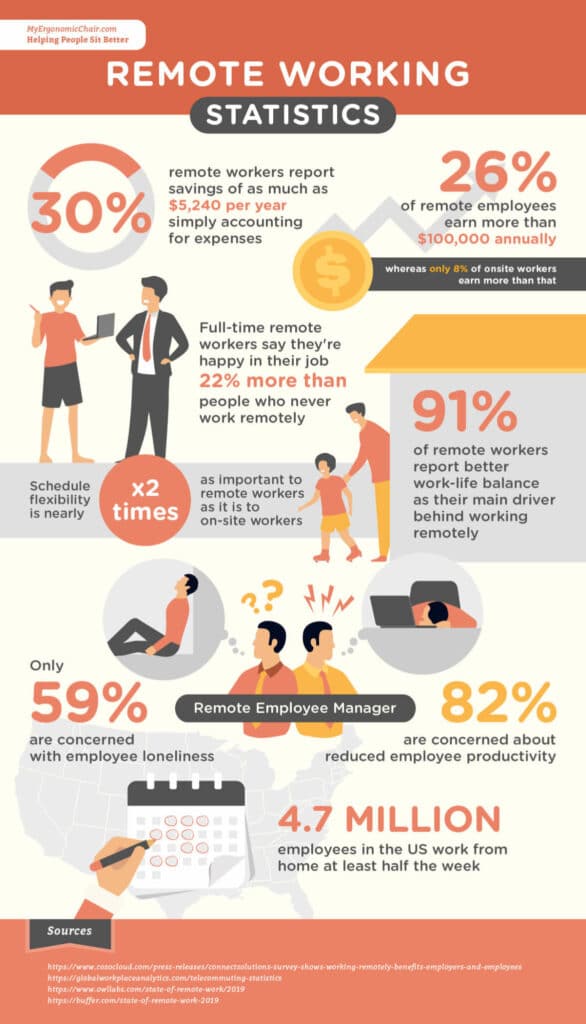Remote work is the new work arrangement norm. However, even without the COVID19 pandemic, there are an increasing number of people finding satisfaction from a work-from-home setup with their respective employers.
According to Statista, 17 percent of American employees worked from the comfort and security of their homes at least five days a week. Another 18 percent worked away from an office setting at least once a week.

The still-ongoing global health concern only accelerated the shift in business operations from a strictly office-only setup to a work-from-anywhere scheme.
More than 44% of American employees now work remotely five days a week, while nine percent accomplish their duties outside office premises three to four days a week.
You might also be interested reading Recruitment And Selection: How To Hire The Right Person For the Job
The Manufacturers Alliance asked its member-organizations about their remote work practices to paint a clearer picture of the work arrangement’s post-pandemic outlook.
Their research says more than three-quarters of non-production employees work remotely effectively, while 92 percent of company executives consider remote work programs effective. Many industry leaders also want to continue with the arrangement after the pandemic.
While these figures are promising, some business organizations might still be hesitant to embrace the remote work model. In a startling revelation by Gleb Tsupursky of Disaster Avoidance Experts, many business leaders require their employees to return to work in an office setting because of several cognitive biases.
The Harvard Business Review also underscored trust issues as the most fundamental concern undermining the effectiveness of the remote work model. Managing remote teams is more stressful than handling employees and their work in a centralized setting.
However, managing remote employees should not be stressful, challenge a manager’s authority, cause irreparable psychological damage to the supervisor, or bring the company’s untimely downfall.
Managers, supervisors, team leaders, and business organizations as a whole can observe the following measures for managing remote teams effectively.
Start by Hiring People Who Can Manage Themselves
A Gallup survey revealed that 85 percent of workers are either not engaged or are actively disengaged at work, resulting in $7 trillion worth of productivity losses.
Unfortunately, any employee who is not the right fit for the job will undermine the stellar performance of the rest of the team. It is a clear example of the cliché an object is only as strong as its weakest point.
That is why businesses must do everything they can to hire remote workers who can manage themselves. Ideally, employees must share the company’s values, possess the necessary self-management skills, and retain an admirable work ethic.
Self-managing remote employees know when and how to execute their work responsibilities and when to ask for tactical guidance and strategic advice. They have a unique appreciation of how invested resources create value for customers.
They welcome constructive criticisms, knowing these improve self-management skills. These employees can identify issues readily and propose solutions instantly.
Unfortunately, finding the right people with self-management skills can be a tough requirement for the organization’s human resource department. Nevertheless, thinking outside the box should help HR personnel devise better ways of recruiting and hiring the best remote workers.
It would be best to frame interview questions to assess a candidate’s behavioral skills. The company must understand a candidate’s personality, communication styles, problem-solving skills, decision-making abilities, and strengths and weaknesses.
Having the right people in the team can make managing teams remotely more effective and stress-free.
Develop and Implement an Effective Virtual Onboarding Process
Hiring self-managing people for remote work is only part of ensuring effective remote work management. It is also crucial to get them onboard the correct way.
Unfortunately, the ongoing pandemic shatters conventional onboarding processes. Without in-person interactions, orientation programs and other onboarding activities can pose challenges to an ill-prepared organization.
It would be best for remote teams to leverage virtual meeting tools. Every team member must be aware of the importance of running effective virtual meetings to make new hires feel welcome. Ideally, their PC cameras should always be on to allow team members to say ‘hi’ to fresh faces instantly.
Remote teams can also solicit volunteers to be the recruits’ buddies for a few weeks, guiding them through the ins and outs of remote working. Peers can answer questions of new hires, share experiences, and offer tips or pieces of advice to newcomers.
Organizations can develop a tailor-made onboarding plan. It can include sending e-packets to recruits several days before the actual work, allowing them to feel welcome, valued, and appreciated. Managers can also share links to online company resources to smoothen the onboarding.
Onboarding managers can set everything up for new hires, making their transition into the organization smoother. Scheduling informal chats between new hires and leaders, managers, and supervisors throughout the organization also help.
Set and Manage Realistic Expectations
Business leaders and management gurus agree, core values matter. A company’s core values define what it stands for and what it hopes to achieve. An organization’s theoretical foundations – vision, mission, and strategic objectives – emanate from its ideals.
That is why it is imperative to hire people who share the same values or appreciate them enough to make these ideals a part of their everyday lives. Aligning employee values with company ideals is crucial to ensuring success.
Companies must recognize that values empower people to decide and act without a supervisor or manager. They have the business’s best interest at heart, allowing them to manage their tasks and responsibilities.
On that note, it would be best for managers to set their expectations right from the get-go. Employees deserve to know what employers expect from them. The message should be as clear as possible and complete with frequent reinforcement if needed.
However, leaders and managers will do well to manage their expectations. Some degree of flexibility and empathy is fundamental to ensuring the success of a remote work model.
One must recognize remote work also presents new challenges to the team. While employees might be keen on keeping their primary responsibilities vis-à-vis company expectations and core values alignment, additional tasks can throw them off balance.
Businesses that want to learn how to manage remote teams efficiently should consider revisiting their core values and communicating these to everyone in the organization frequently, effectively, and clearly.
Support Remote Team Members
Not everything about remote work is rosy. It can also present problems to remote workers.
The American Psychiatric Association released its survey results in May 2021, revealing that work-from-home employees experienced mental health issues.
Two-thirds of WFH employees felt lonely or isolated, with 17 percent feeling the same way all the time. Remote workers also find it challenging to get away from their work responsibilities at day’s end.
The same survey also showed that, while employers have shown more openness to addressing mental health issues, 40 percent of employees fear retaliation if they seek professional measures for their mental health concerns. Only 28 percent of employers support their workers with these issues.
Therefore, a company must support its employees to manage remote teams effectively and efficiently.
Businesses with a hybrid or remote work arrangement can provide support channels for their remote teams. For example, a virtual high-five underscores a team member’s efforts, making him feel good about himself. Daily digital kudos can also help.
Opening multiple communication channels also helps, enabling WFH employees to seek guidance and advice whenever they need them. Having a counselor on standby is always an excellent measure, although instituting a network of support groups can help lessen the burden of working remotely.
Regular check-ins using video-conferencing platforms can also help remote workers. Managers and team leaders can ask questions that build self-esteem, such as accomplishments each employee is proud of, issues they struggle with, and areas they want to improve.
Remote team leaders can also benefit from coaching, motivating their team members more efficiently and effectively. It strengthens esprit de corps and a sense of belonging, enabling the remote team to function as one.
Business organizations must realize that happy team members translate to happy customers. The company must do everything it can to make each remote team member feel good about what he is doing.
Balanced Communication
In 2019, the International Journal of Recent Technology and Engineering published a report on the relationship between communication and employee performance. Good communication improves workforce performance, ensures teamwork, and encourages decision-making and learning.
Although pre-pandemic business communication patterns are already at an all-time high, they soared higher during the pandemic. A Microsoft data analysis showed that remote workers experienced a 48 percent increase in chats and a 55 percent growth in virtual calls and meetings per week.
The report also highlighted the lack of separation between life and work, with 69 percent of remote work chats extending beyond work hours.
Before the pandemic, office workers receive e-mails, make and take calls, attend meetings, accomplish reports, and perform other communication-related activities. Remote work did not eliminate these tasks – it increased it.
Unfortunately, the brain can only process so much information at a time. Information overload can make employees feel anxious, overwhelmed, mentally fatigued, and powerless. It can make decision-making more challenging, which can lead to bad decisions.
While communication is more crucial for remote work than traditional office-based arrangements, companies must strive to avoid over-communicating. Organizations can minimize unnecessary virtual meetings. It would also help for managers to be present during these virtual meetings, acknowledging team members’ efforts to do the same and recognizing precious time.
As mentioned, one of the ways for managing remote teams effectively is by setting clear expectations. One reason why remote workers are feeling burned out is the absence of a clear line between work and life. They do not know when their day’s official work ends.
Managers and team leaders should also not abuse chat boxes and other informal communication channels.
Remote work calls for a more balanced communications strategy to avoid overwhelming employees, ensure workforce well-being, and increase productivity.
Leverage the Right Technology
Managing remote employees is more effective and efficient with the right technologies. Thankfully, the pandemic saw a rise in productivity tools that improve workflow processes, facilitate more efficient communication, and ensure better data security.
While leveraging technology is a must for a successful remote work model, organizations must not fall into the trap of flooding their remote workforce with too many technologies.
A Cornell University and Qatalog study in 2021 revealed that remote workers waste at least five hours weekly fussing with ‘productivity’ tools. The report underscored the need for a cross-functional platform to avoid work duplication while facilitating ease of information access.
The report showed that 54 percent of remote workers found data too fragmented across different productivity tools, making them spend at least an hour a day searching and consolidating information.
Switching between tools also dampened employee productivity. The report also highlighted oversharing due to fear of the message getting lost in the web of interconnected platforms. Three out of five remote workers find it difficult to determine what other employees are working on, further increasing time wastage.
That is why businesses must examine and evaluate the HR and productivity tools they have or wish to integrate into their remote work arrangements. It would be best to get technologies with cross-platform functionalities, facilitate ease of access, and consolidate critical information with few user inputs as possible.
Many technologies today offer a wealth of functionalities, such as customer relationship management, collaboration, project management, task management, contact management, time management, and others.
The company must also train its remote workforce in using these technologies, focusing more on improving process workflows, ensuring more efficient communication, fostering more effective collaboration, and guaranteeing reduced workload.

Focus Not on Activities but Outcomes
One of the most common mistakes of remote team leaders is their singular focus on the team’s activities. They are like hawks hovering above their team members, constantly looking for signs of neglect of duties secondary to failure to perform certain tasks.
While Machiavellian in origin, focusing on outcomes instead of tasks allows organizations to convey their message to their remote workforce. It underscores the notion that there are hundred different ways of accomplishing a particular mission.
One person might devise a strategy that allows him to deliver the outcome without following the activities to the letter. Other people, often those with minimal creativity, tend to stick to predetermined tasks. In either case, the organization still wins because its workforce delivers the expected outcomes.
To be clear, the language of achievement focuses more on milestones, outputs, deliverables, and decisions. On the other hand, activities have to-do lists, inputs, discussions, and tasks.
Businesses must be clear from the start about what they expect from their remote employees. Their expectations should also emanate from their vision and strategic objectives. As long as employees know and understand these results-based expectations, companies can feel more confident about delivering the outcomes.
Such a technique can also benefit employees working remotely. They feel empowered. Remote workers know their leaders and managers trust them to produce milestones and deliver the expected outcomes. It builds value in their competencies, including creativity and decision-making.
Provide Remote Teams the Resources for Performing their Work
Not everyone has the right resources to perform their remote work effectively and efficiently. Some might not have stable, secure, and fast internet connections, while others might not have the correct tools in their computers. Headsets, PC cameras, recording devices, printers, and other equipment typically found in office settings might be unavailable at home.
While these things might seem trivial to some people, they matter to those who want to deliver the best outcomes for their respective organizations. That is why it is essential for companies with a hybrid work model to equip their remote workforce with the necessary resources for them to work as efficiently and effectively as possible.
However, it does not end with these physical resources. Technical and personnel support are also crucial. The company must provide assistance should there be concerns about a program, data breach, or other technical issues.
Remote workers must have access to company resources wherever they might be working from. They can talk to a counselor or a team leader and ask for guidance. They can escalate concerns that require the decision of the upper management easily.
Remove Obstacles to Remote Work Productivity
As mentioned, remote work offers many challenges. Switching off from work is one of the most challenging aspects of working remotely, leading people to overwork. The home now serves both official and personal functions. Drawing a line between the two becomes increasingly difficult for some remote workers.
Office work has a definite period. People log in at the start of a shift and log out at the end of the day. They no longer have to worry about their work responsibilities when they step out of the office building.
Unfortunately, remote workers cannot do this. While time management initiatives equip workers with task prioritization competencies, something in the home always crops up to disrupt the routine.
Most remote employees have spouses and children with varying needs. Household chores and demands often complicate things for remote workers. Noisy neighbors, power interruptions, and other nuisances can also make working from home more challenging.
Removing these obstacles is not easy. However, companies can use available technology to remind their remote workers of the need to stop their work and tend to personal matters. Scheduling breaks and virtual team socialization can also help.
Remote workers can also set their reminders and appointments with digital tools. Dedicating a room in the house for work can also reduce distractions, especially if one needs to focus on getting the results. People with young children might also want to consider getting childcare to minimize work interruptions.
Managers and team leaders can meet team members virtually to determine the distractions and obstacles in their work-from-home settings. The organization can then devise a plan to minimize, if not eliminate, these issues.
Encourage and Promote Remote Social Interactions
According to an American Psychiatric Association report, two out of three remote workers feel lonely or isolated. These negative feelings are more pronounced among the young adult workforce aged 18 to 44 years. The findings reflect Erik Erikson’s Psychosocial Development Theory, where young adults strive for intimacy while warding off isolation.
Research by Steven Cole and John Cacioppo revealed that feelings of loneliness and social isolation promote anxiety by affecting brain neurotransmitter levels. The study also showed that acts of kindness could reduce such negative emotions.
Hence, it would be best for team leaders and managers to encourage everyone to show acts of kindness. Organizing a virtual charity event and getting everyone involved can soothe loneliness. Inspiring remote team members to give small thank you notes to each other also helps.
Companies can also tap their employee resource groups focusing on shared interests and cooperation. These employee-led teams can bring all remote teams together to build stronger bonds and create a more enduring esprit de corps.
Celebrating special events creatively can also encourage team members to feel good and not feel alone. Businesses can ship party hats, chocolate-covered corns on the cob, or DIY cocktail kits to remote employees to participate in a remote team meeting toast.
Agenda-less opt-in meetings and virtual coffee dates also work. Inviting a senior manager to inspire or give tips to the remote team can also foster a sense of belongingness while minimizing feelings of isolation.
Team leaders can also structure their virtual meetings, allotting sufficient time for non-work-related and personal conversations.
Companies can think of many ways for getting their remote workers out of their feelings of isolation and loneliness. The point here is to involve each team member, acknowledge their efforts, and recognize their contributions.

Recognize and Reward Employees
A study published in the International Journal of Creative Research Thoughts underscored the positive correlation between recognition and employee motivation.
Frederick Herzberg’s Motivation Theory also highlights two crucial factors impacting an employee’s job satisfaction. He says that hygiene measures (supervision and salary) can reduce work dissatisfaction, while motivation factors (achievement and recognition) encourage commitment, creativity, and productivity.
These theories provide a basis for organizations’ reward and recognition programs. It is essential to note there is a difference between the two.
Rewards are tangible items given to people for their performance. It can be gifts or awards which the recipient can enjoy or display. On the other hand, recognition is almost always intangible, often taking the form of praises and call-outs.
Rewarding remote workers for their accomplishments boost their work commitment, satisfaction, and motivation. The award should motivate other team members to do the same or strive for it. Unfortunately, some people might resent perennial recipients.
That is why recognizing everyone’s contribution to the team effort is crucial to keeping the team spirit high. The recognition does not have to be outlandish or extravagant. A virtual high-five or a digital pat on the back is welcome. Personalized words of encouragement also help.
Herzberg’s theory also calls for hygiene measures, equating to salary and supervision. It would be best for companies to pay their remote workers on time, every time. The rigors of remote work are stressful enough. Not knowing if one gets paid on time can add to the worker’s anxiety.
It would be best to revisit the compensation package, including bonuses and promotions. These financial remunerations might be just in an office work setting but not in a remote work arrangement. If the evaluation shows a necessary salary increase, the company must be ready to give it to its employees.

Conclusion
Organizations with a remote work arrangement model can observe the following tips to manage remote employees and teams effectively.
- Hire remote workers with high self-management skills
- Ensure an effective virtual onboarding process
- Set and manage realistic expectations
- Support remote team members
- Balance communication
- Leverage the right technology
- Focus on outcomes, not activities
- Provide remote teams with the correct resources for performing their work
- Remove obstacles to remote work productivity
- Encourage and promote remote social interactions
- Recognize and reward employees
Managing remote teams effectively is a balancing act. Companies must ensure the wellbeing and productivity of remote teams while accomplishing the company’s operational and strategic objectives simultaneously. While there are detractors to this work arrangement model, remote work is here to stay.
